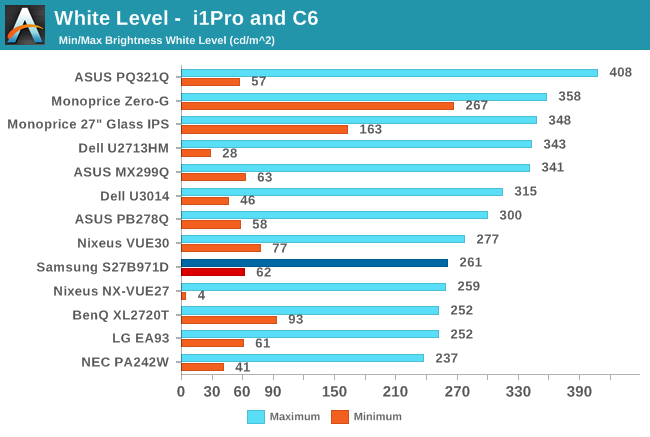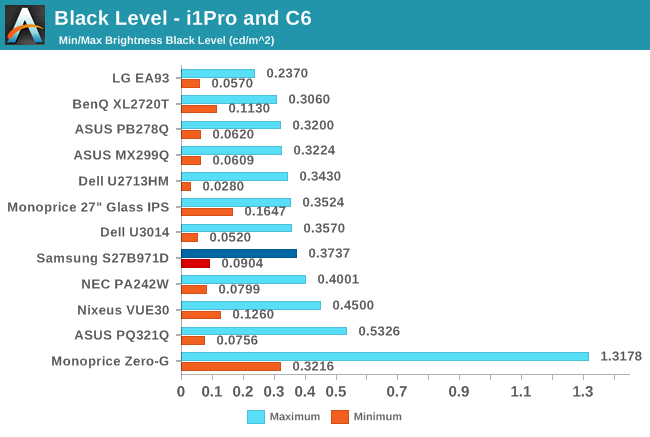Samsung S27B971D Monitor Review
by Chris Heinonen on October 31, 2013 12:00 PM ESTThe maximum light output of the S27B971D is only rated for 250 cd/m^2 in the Standard mode, which is lower than we expect to see. For all these pre-calibration measurements I use the sRGB mode of the display. It is the most accurate out of the box and what I would use if I couldn’t calibrate the display.
With the brightness set to maximum we get 261 cd/m^2 of brightness on a white screen. This is slightly more than the specs say, which is nice to see, but 10 nits is a pretty small difference. Set down to the minimum we get 62 cd/m^2 which is a good range of brightness. Many displays stop well before 100 cd/m^2 which can be too bright for nighttime or light controlled environments. If you do use the high brightness mode you can get 321 cd/m^2 from the S27B971D, but you give up accuracy. I’d skip it, unless there was a specific instance where it was helpful.

As PLS is similar to IPS I expect to see black level results that more closely mirror it than a VA style panel. The black levels on the Samsung are a bit underwhelming. With the backlight at maximum the black level is 0.3737 cd/m^2; at minimum it is 0.0904 cd/m^2. With values like this I’d like to see a higher white level as the contrast levels are going to be only fair.

As I suspected the contrast levels on the Samsung are only 700:1 and 690:1. These are OK for an IPS/PLS panel but not amazing. Samsung rates the display at 1,000:1 for static contrast but I didn’t find a way to achieve those numbers unless you use the dynamic contrast system (which I don’t). So it's a fair result but not great.











52 Comments
View All Comments
Alan G - Saturday, November 2, 2013 - link
Yes, writing to the monitor's LUT which is why NEC monitors are so easy to work with. I've used both their own Spectraview software or the ArgylCMS freeware to calibrate it. Of course the needs of photographers are quite different from those who game on their computer for which this monitor might be sufficient.Gothmoth - Saturday, November 2, 2013 - link
well EIZO or QUATO is the goto. but NEC spectravies are not bad below 2000 euro.bobbozzo - Friday, November 1, 2013 - link
Hi, please include the Aspect Ration on the specs chart on the first page of all monitor reviews.This one appears to be 16:9 :(
Thanks!
bobbozzo - Friday, November 1, 2013 - link
arg... Aspect Ratio!AnnonymousCoward - Friday, November 1, 2013 - link
30ms lag is unacceptable, and 67% gamut is bound to look dull next to a wide gamut playing any game. Too expensive, too.Gothmoth - Saturday, November 2, 2013 - link
test EIZO and QUATO monitors... why do you test all the dell and samsung consumer stuff but not the more pro oriented monitors out on the market?eizo CX240 or CX270... they are the competition to the NEC PA271 or PA272.
not these dell or samsung monitors.
cheinonen - Sunday, November 3, 2013 - link
As soon as Eizo or Quato will send me a display I'll test one. Until then I can't!hoboville - Monday, November 4, 2013 - link
Holy cow, I was thinking "Hmm this is a nice monitor, I've been wanting to get 1440p". Then I saw the price. What are they thinking?JakeLee - Tuesday, November 5, 2013 - link
Aren't you people aware that Samsung got caught cheating customers with fake calibration reports last year?Part 1: (partially English)
http://colormgmt.com/60166005864
Part 2: (Korean only)
http://colormgmt.com/60166308743
Samsung's excuse (Korean)
http://samsungtomorrow.com/2914
They admitted that the reports are "accidentally" misprinted, although the monitors are hand calibrated each through four stages.
It might be true, but Samsung has a very long list of shady practices....
cheinonen - Tuesday, November 5, 2013 - link
Thanks for posting that. I hadn't seen that before so it is good to see. That would certainly explain why the measurements on the included data sheet didn't match up to the performance I measured with CalMAN myself.